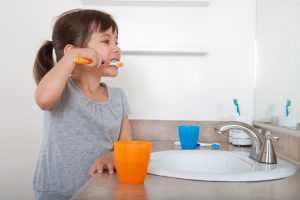Pop Quiz: Threats to the Great Lakes
The Great Lakes face many obstacles and threats, from invasive species to clean water affordability. Put your knowledge to the test! Go here to take the pop quiz!
Household Waste – That’s Garbage!
What’s the first thing you think of when you hear the word “garbage”?
Smelly? Gross? Disgusting? It Stinks!
Garbage isn’t a very nice thing to have around. That’s why we make sure to put our garbage in the trash can where it belongs. But did you ever think about what happens to garbage after you throw it away?
Garbage trucks take our trash to landfills, where it is buried under layers of soil. But just because you can’t see your trash anymore doesn’t mean that it disappears. Over time, some kinds of trash will rot away (decompose) but this can take many years. For example, a banana peel can break down in less than a month, but a plastic pop bottle takes much longer.
How long do you think it takes for a plastic pop bottle to decompose after you throw it away?
2 months? 1 year? 150 years? 450 years?
Take a look at how long it takes things to decompose including that pop bottle:
| How Long Until It’s Gone? | |
|---|---|
| Glass bottle | 1 million years |
| Monofilament fishing line | 600 years |
| Plastic beverage bottle | 450 years |
| Disposable diapers | 450 years |
| Aluminum cans | 80-200 years |
| Foamed plastic buoy | 80 years |
| Tin can | 50 years |
| Leather | 50 years |
| Nylon fabric | 30-40 years |
| Plastic film canister | 20-30 years |
| Plastic bag | 10-20 years |
| Cigarette filter | 1-5 years |
| Wool sock | 1-5 years |
| Plywood | 1-3 years |
| Waxed milk carton | 3 months |
| Apple core | 2 months |
| Newspaper | 6 weeks |
| Orange or banana peel | 2-5 weeks |
| Paper towel | 2-4 weeks |
| Sources: U.S. National Park Service; Mote Marine Lab, Sarasota, FL and “Garbage In, Garbage Out.” Audobon magazine, Sept/Oct 1998. | |
Roughly 22 million tons of plastic ends up in the Great Lakes each year, and it never really goes away. Think about how much of that plastic could have been kept out of the water if it would have been reduced, reused or recycled.
Here are some things to think about:
1. Can it be reused?
Lots of times we throw away items that can still be used. For example, an old peanut butter jar can be used to hold small toys, or a soup can works great as a pencil cup. If you’ve only written on one side of a piece of paper, save it to use the back side for scrap paper. Your old winter coat might not fit you anymore, but it might still be useful to someone else, like a younger cousin or the neighbor kid.
![]() Be creative! Here are some fun ideas from Kinder Art of things you can make with items you might otherwise throw away – ART RECYCLED
Be creative! Here are some fun ideas from Kinder Art of things you can make with items you might otherwise throw away – ART RECYCLED
2. Can it be recycled?
Recycling means to process an old product into a new one. For example, when you return an aluminum pop can to the store, the can gets melted down and a new can is made out of the metal. Many materials, including glass, plastic, paper, and metal can be recycled, saving energy and creating less waste for landfills.
Did you know that the recycling rate in Michigan is only 15%? If we are going to reduce how much waste makes it into our waterways, we need to do a better job at recycling!
Visit the Keep America Beautiful’s Recycling journey to follow the journey of an aluminum pop bottle, or can on its way to be recycled.
3. Can it be composted?
Composting is nature’s recycling system. Organic materials (items made out of things that were once living, such as plants) can be piled together and left to decompose (to break down with the help of microorganisms). Over time, items you once recognized, such as banana peels, apple cores, newspaper, or leaves will transform into a black, soil-like substance called humus. This humus contains lots of nutrients and can be mixed into your garden to help new plants grow healthy and strong. By composting, we not only keep lots of smelly, soggy garbage out of the landfill, but we create something that is valuable and truly useful out of what would have been wasted.
Learn all about how to start composting from Michigan State University- Composting: A Smart Garden Practice.
4. Is it hazardous?
Many items, such as cleaning products, batteries, bug spray, or paint, contain chemicals that may be dangerous if they got into the environment. Although landfills are made with thick liners that are supposed to prevent leaks, sometimes the liners break down and chemicals from these hazardous products contaminate the soil and the water. Instead of throwing these items into the garbage, take them to your local Household Hazardous Waste Collection Center to be disposed of properly. You can find your nearest Collection Center by calling your county health department listed in the Your Local Resources section of this website.
Water Consumption
Direct Water Use
Let’s take a look at how much water you use in a normal day. Use the following chart to figure out how many gallons of water you use to complete everyday tasks.
| Action | Gallons of Water Used |
|---|---|
| Brushing your teeth (with water running) | 3 gallons per minute |
| Flushing the toilet | 5 gallons |
| Taking a shower | 5 gallons a minute (50 gallons for a 10 minute shower) |
| Washing Dishes under running water | 30 gallons |
| Washing clothes | 37 gallons per load |

Make sure you turn the water off! The water should not be running while you brush your teeth but only to wet the toothbrush before brushing and then rinsing after brushing.
Time those showers! Just a few minutes makes a big difference for saving water!
How much water do you use? If you brush your teeth, take a 10 minute shower and use the restroom three times in a day you’ve used almost 70 gallons of water—and that’s without even helping with any chores! Are you surprised?
Indirect Water Use
Reducing the amount of water we use directly is an important step toward conserving water.
We also have to consider our indirect water use. When you are using paper to do your schoolwork, eating a hamburger for lunch, or reading this webpage on a computer, it may not seem like there is any water involved. But in order to make the paper, the hamburger, and the computer, the manufacturer had to use a LOT of water.
Take a look at just how much water is needed to make a few of the things we use every day:
| Item | Gallons of Water Needed to Make this Item |
| 1 sheet of paper | 2.5 gallons |
| 1 pound of steel (used to make things like cans) | 31 gallons |
| 1 pound of plastic (used to make things like pop bottles) | 70 gallons |
| 1 gallon of gasoline | 70 gallons |
| 1 pair of jeans | 1,800 gallons |
| 1 pound of hamburger | 2,464 gallons |
| 1 desktop computer | 7,300 gallons |
| 1 car | 65,000 gallons |
Can you believe it? We can’t control how much water is used to make these items, but we can make every effort to reduce our use of these products in order to conserve water. See the tips below for decreasing indirect water usage:
- Recycle pop bottles, cans and paper
- Recycling uses much less water than creating a product from scratch
- Reuse or repair items rather than buying new ones
- Donate reusable items that you no longer want
- Walk or ride your bike to school
- For every gallon of gas saved, 70
gallons of water is saved also!
- For every gallon of gas saved, 70
- Buying locally made products
- Local products don’t travel as
far so they save gas as well
- Local products don’t travel as
